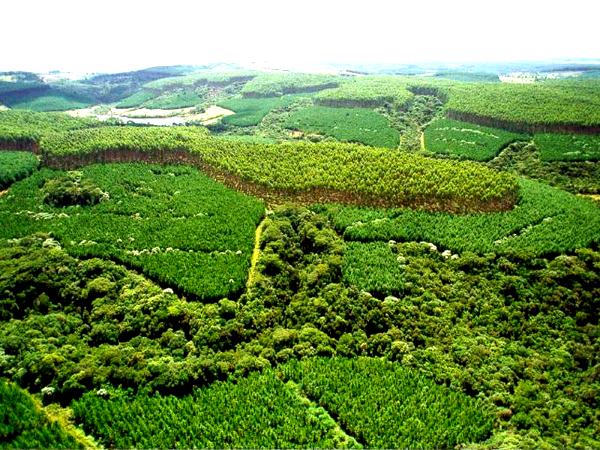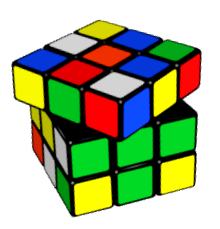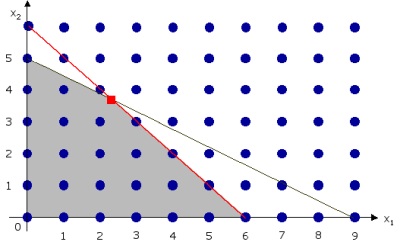The “Temporal” Rubik's Cube inside the Planning of Forests
(38, Brazil)
I work with Forest Planning, in one of the biggest Brazilian paper and cellulose companies. One day, I was asked to do a presentation to explain my work to adolescent students. I used the Rubik's Cube to do this.
Paper is made of wood. The paper you use to print books was, one day, a tree. The tree is cut down, cooked in a giant pressure cooker with chemicals, filtered to extract the fibers, and the fibers are compressed to make a sheet of paper.
In Brazil, we don’t cut native trees. The trees are always from reforestation areas. In each of these areas, we plant the trees (eucalyptus and pinus) and around 7 years later, it is ready to be harvested. We call each of these areas a “block”.
 1 Harvesting blocks
1 Harvesting blocks
My job is to schedule the sequence of jobs to be planted and harvested. Which block do I harvest today? And tomorrow? And the day after tomorrow?
It is a giant combinatorial puzzle, like a giant Rubik's Cube.
Seen easy. But it is not, especially when there are 15.000 blocks.
In this moment, I divided the group of students in 6 groups, and gave each group a 3x3x3 scrambed cube.

I gave then 5 minutes to solve the cube.
Surely, none of the groups solved the cube.
The cube is fascinating, because it is easy to understand what to do, but very very hard to solve.
I have these 15.000 blocks to be scheduled, and each one has a feature. Different species, plantation dates, distances to the mill, roads conditions. Each block of trees is like a piece in this gigantic Rubik's Cube.
I gave the groups 5 more minutes, but with a different goal: to solve only one face, say, the white face.

Now, every group could solve the white face of the cube. It is several orders of magnitude easier than solving everything.
I resumed the presentation.
In Forest Planning, we have several goals. We must supply the mill with wood. But the harvest and logistics conditions must be the most constant possible with time. For example, we cannot have logistics distance of 10 km in one month and 200 km in other, because the number of available trucks is constant.
Each of these constraints is like a face of the cube to be solved.
Now I asked to the groups to solve another face of the cube, say the yellow face.
Every group did it, but they scrambled the white face previously solved.
I resumed. It is easy to arrange the harvest scheduling to fill the needs of one area, say logistics. Or harvesting machines. Or roads. Or balance of species to the mills. But is very hard to arrange all of them at the same time. The forest planning has to reach the global optimum solution, not the local optimum. It has to solve all faces, not one face in the sake of the others.

2 Wood supply chain
Now, I picked one of the cubes. And solved all the 6 faces in some 50 seconds.
To solve the Rubik's Cube, we use a series of algorithms that help to order the pieces in the faces.
To solve the Forest Planning Cube, we use a technique called Linear Integer Programming. We basically describe the pieces available to us, the constraints (the faces of cubes) and the weights of the goals.

3 Linear Integer Programming
In the Forest Cube, each goal can have a different weight in the solution. For example, this month the company wants the best areas for harvesting, and only a viable (or better, feasible) solution for logistics. Other month, it can be the opposite.
The last important item to note is that the planning has to think about the future. It is like a “temporal” Rubik's Cube, where the solutions of today influence the solution of tomorrow. We can think in layers. Today I have to solve only the bottom layer. Tomorrow, I will have to solve the mid layer without scramble the bottom one. And the day after tomorrow, to solve the top layer.
It is easy to find a very good forest plan today: I just harvest all good blocks near the mill. But, in the future, the bill will come, and it will be expensive: I will have to harvest complicated blocks in hard to access terrain.
It is like spending all the money in my bank account today. I will have a very happy short term, but a potentially disastrous long term.
In forest planning, the cycles of life of forests are long. The mistake I do today will be affect the company only in tens of years. But, as in a “temporal” Rubik's Cube, if I begin with the wrong solution today, I will never achieve the right solution the day after tomorrow.
To solve a combinatorial puzzle, to put the pieces in the right places for each face, to think on the global instead of the local, and in the long term instead of the short term: that’s the “temporal” Rubik's Cube of the Forest Planning! This is my favorite puzzle.